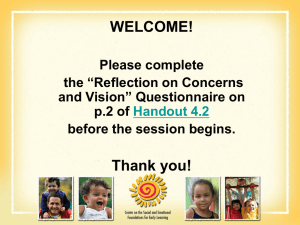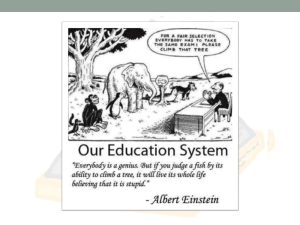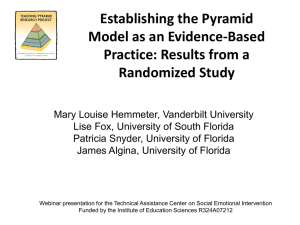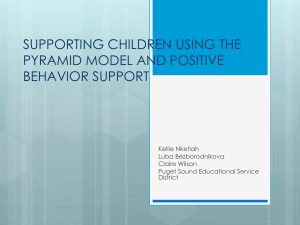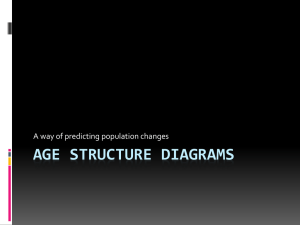Module 4 - Center on the Social and Emotional Foundations for
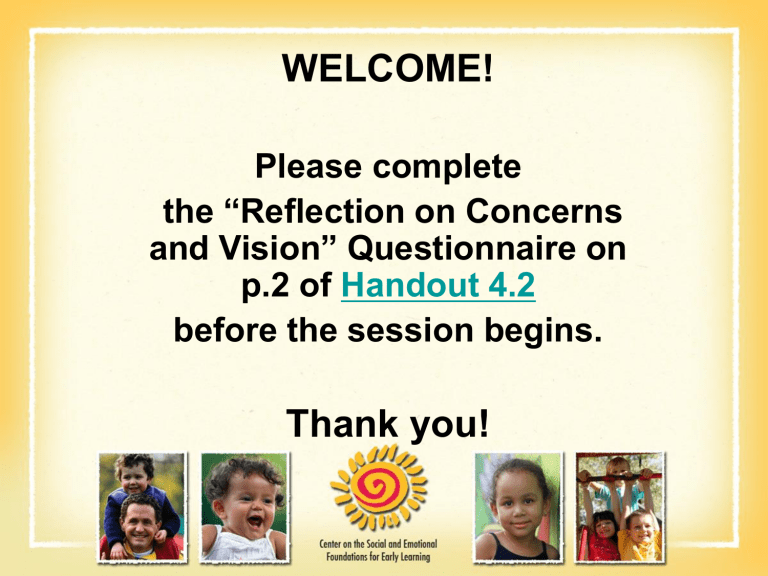
WELCOME!
Please complete the “Reflection on Concerns and Vision” Questionnaire on p.2 of Handout 4.2
before the session begins.
Thank you!
Essential Leadership
Strategies for
Adopting the Pyramid Model with Fidelity
Module 4
Barbara J. Smith, Ph.D.
Purpose of Workshop
• Provide time to reflect and focus.
• Present an evidence-based framework and practices.
• Provide effective tools and strategies for implementing the framework and practices.
Learner Objectives
Participants will:
• Describe an evidence-based framework for addressing social-emotional development and challenging behavior.
• Identify strategies to address common challenges to evidence-based practices.
• Identify effective leadership strategies including collaborative planning and professional development.
• Apply collaborative action planning strategies for improving children’s social-emotional and behavioral outcomes.
Agenda
Part 1: Knowledge and Skills
• Introduction
• Importance of Social Skills and Behavior
• The Pyramid Model
• What is Leadership?
• Fidelity of Implementation, Collaborative Leadership and Professional Development
• Effective Collaboration and Teaming Strategies
Part 2: Application and Example s
• Effective Professional Development Strategies
• Applying the Strategies and Tools at the Community and Program Levels
Resources for Achieving
Objectives
• CSEFEL What Works Briefs, Training Modules, and other web based resources www.vanderbilt.edu/csefel
• TACSEI (Technical Assistance Center on
Social-Emotional Intervention) Recommended
Practices fact sheets, tool kits, and other web based resources www.challengingbehavior.org
H4.10
Table Activity
• With the people at your table
• Take 3 minutes
• On the flip chart, draw:
–a picture of something that represents building a better life for children and families in your community
Report
• Describe the experience
• Notes taken on flip chart at front of room
• To be used later in the workshop for discussion
CSEFEL Definition of Social-
Emotional Development
The term social-emotional development refers to the developing capacity of the child from birth through five years of age to form close and secure adult and peer relationships; experience, regulate, and express emotions in socially and culturally appropriate ways; and explore the environment and learn – all in the context of family, community, and culture.
Definition of Social-Emotional
Development, continued
Caregivers promote healthy development by working to support social-emotional wellness in all young children, and make every effort to prevent the occurrence or escalation of socialemotional problems in children at-risk, identifying and working to remediate problems that surface, and when necessary, referring children and their families to appropriate services.
Adapted from ZERO TO THREE, 2001
TACSEI Definition of Challenging
Behavior
Any repeated pattern of behavior, or perception of behavior, that interferes with or is at risk of interfering with optimal learning or engagement in pro-social interactions with peers and adults. Challenging behavior is thus defined on the basis of it’s effects.
H4.3
Examples of Challenging
Behaviors
• Physical and Verbal Aggression
• Noncompliance / Defiance
• Self-Injury
• Disruptive vocal / motor responses
(screaming, stereotypic behavior)
• Destruction of property
• Withdrawal
Examples of Challenging Behaviors
For Infants and Toddlers
• Attachment difficulties
• Sleeping / eating difficulties
• Excessive crying
• Difficulty in soothing
Why All the Fuss?
• Name some challenging behaviors that you and your staff have experienced.
• How do these behaviors make you and your staff feel?
• Handouts of facts.
H4.4
, H4.5
What Positive Social-Emotional
Outcomes Can Be Expected from
Evidence-Based Practices?
• Decrease in:
– Withdrawal, aggression, noncompliance, and disruption
– Teen pregnancy, juvenile delinquency, and special education placement
• Increase in:
– Positive peer relationships including understanding of friendship, cooperation, and sharing
– Self-control, self-monitoring, self-correction, and improved social-emotional health
– Academic success
Challenges to Effective Practices
Focus groups with T/TA providers, state policy makers, program personnel, and families identified Four Categories of Challenges :
• Lack of knowledge / skill
• Beliefs / Attitudes
• Lack of collaboration within programs, with families, and within communities
• Lack of adequate fiscal resources and procedures
H4.2
Activity: What are strategies for addressing these challenges?
1. Lack of knowledge / skill
2. Beliefs / Attitudes
3. Lack of collaboration within programs, with families, and within communities
4. Lack of adequate fiscal resources and procedures
An Evidence-Based Framework:
The Pyramid Approach
• PROMOTION
• PREVENTION
• INTERVENTION
The Pyramid Model:
Promoting Social and Emotional Competence and Addressing
Challenging Behavior
Tertiary:
Few
Children
Secondary:
Some
Children
Universal:
All
Children
H4.6
, H4.7
Highlights of Module 1
Nurturing and Responsive
Relationships
• Foundation of the pyramid
• Essential to healthy social development
• Includes relationships with children, families and team members
High Quality Environments
• Inclusive early care and education environments
• Comprehensive system of curriculum, assessment, and program evaluation
• Environmental design, instructional materials, scheduling, child guidance, and teacher interactions that meet high quality practices as described by NAEYC and
DEC
Supportive Home Environments
• Supporting families and other caregivers to promote development within natural routines and environments
• Providing families and other caregivers with information, support, and new skills
Highlights of Module 2
We Teach
“If a child doesn’t know how to read, we teach .”
“If a child doesn’t know how to swim, we teach .”
“If a child doesn’t know how to multiply, we teach .”
“If a child doesn’t know how to drive, we teach.”
“If a child doesn’t know how to behave, we………… teach? ……… punish?”
“Why can’t we finish the last sentence as automatically as we do the others?”
Tom Herner (NASDE President ) Counterpoint 1998, p.2)
Identifying Teachable Moments
(When teaching has an impact!)
Friendship Skills
• Gives suggestions (play organizers)
• Shares toys and other materials
• Takes turns (reciprocity)
• Is helpful
• Gives compliments
• Understands how and when to give an apology
• Begins to empathize
Targeted Social-Emotional Supports
• Self-regulation, expressing and understanding emotions, problem solving, developing social relationships
• Explicit instruction
• Increased opportunities for instruction, practice, feedback
• Family partnerships
• Progress monitoring and data-based decisionmaking
Highlights of Module 3a and 3b
Continuum of Behavior
Social
Withdrawal
Acting Out
Individualized
Positive Behavior Support
• Convene a team
• Conduct functional assessment
• Identify hypotheses
• Develop behavior support plan for all relevant environments
• Implement, monitor, gather data, refine
Pyramid Model Overview
Promoting Social Emotional
Competence Video
– Feature length video
– Overview of Framework
– English and Spanish
– Open captioning
CSEFEL: www.vanderbilt.edu/csefel
TACSEI: www.challengingbehavior.org
Effective Workforce:
Systems and Policies Promote and
Sustain the Use of Evidence-base
Practices
Effective Workforce:
Role of Leaders
Implementation Issues Associated with the Pyramid Model
• Belief that the bottom three levels are already in place
• Lack of understanding about the relationship between environment and social development and problem behavior
• Tendency to want to jump to the top of the pyramid
• Desire for a quick fix
What is Leadership?
Alan Keith of Genentech states:
Leadership is ultimately about creating a way for people to contribute to making something extraordinary happen.
What is Leadership in an
Early Childhood Program?
Who are the Leaders?
Link between Program Leadership and Child and Family Outcomes
“…an adequate infrastructure increases the likelihood that recommended practices will be used to deliver services and supports to young children and their families…”
“…when quality [evidence-based] practices are used consistently it is more likely that children and their families will experience positive outcomes.”
Harbin & Salisbury, Sandall, McLean & Smith, 2000
Effective Workforce: Role of Leaders
Quality of services matters
• Provide Vision of high standards and expectations
• Use evidence-based practices (EBPs)
• Implement the EBPs with fidelity
• Monitor practices and child outcomes
• Provide professional development
• Provide support, policies and resources
• Model collaborative leadership: work as a team!
The Goal
Fidelity of Implementation of EBPs that leads to positive outcomes for children, families, providers, and programs
H4.8
What is Implementation Fidelity?
• The degree to which interventions are accurately and consistently carried out as originally specified by the developers
• The only way to know if a practice or intervention is being accurately applied with fidelity is to measure implementation
See handout by Mincic, Smith & Strain (2009)
Measure Fidelity: Pyramid
Model Fidelity Tools
• Teaching Pyramid Observation Tool
(TPOT)
• The Pyramid Infant Toddler Observation
Scale (TPITOS)
Administrative Support is Key to Implementation Fidelity
• Administrative Leadership and Vision
• Time
• Resources
• Training
Administrative Support is Key
• Coaching
• Data Collection
• Written Policies and Procedures
• Families
BREAK
Adopting the Pyramid Model:
Inventory of Practices & Action Plan
Designed to be used by individuals and/or teams to identify training needs related to four areas of EBPs of the Pyramid Model:
1. Nurturing and Responsive Relationships
2. High Quality Supportive Environments
3. Targeted Social Emotional Supports
4. Individualized Intensive Interventions
H4.9
Inventory of Practices for
Promoting Social Competence
• Best used in a manner to generate reflection and discussion
• Allows for development of an Action Plan that:
– Targets skills for training
– Identifies strategies to support the team in implementing the new practices
– Identifies resources and supports needed to complete the activities or strategies
H4.9
Activity
• As a group, discuss a set of practices from the
Inventory’s action plan.
• What can you, as leaders, do in your work with direct service personnel and families that would lead to the use of these practices? Note these under “Supports and Resources”.
• Have one member of your team be prepared to report to the entire group:
1) the practices and what they mean,
2) the level of the “Pyramid Model” they relate to, and
3) the leadership supports and resources needed
H4.9
Collaborative Leadership and Teaming
Activity
Is Collaboration Effective?
Activity: 15 minutes
Take 5 minutes and by yourself, write one thing for each question:
1) What made a collaborative or team effort you were involved in not worth the time and effort?
2) What made a collaborative or team effort you were involved in worth the time and effort?
3) “Shout out” one of each (10 minutes)
Is Collaboration Effective?
It depends on, who, how, why, what……
What Works
Collaboration…
• is a process not an event
• is hard work: col labor ation
• needs trust and respect: true shared decisionmaking (yours may not be the decision that is chosen!)
• needs buy-in and ownership of all stakeholders: attention to team needs and stage you can’t mandate what matters
(Fullan, 1993)
What Works
Collaborative planning needs to show results; evaluation.
Collaboration and collaborative planning requires:
• objective facilitation
• skills and trust re: collaboration
• shared understanding about current state and what needs to be changed
• shared vision about goals
• ongoing supports and resources, incentives
• shared ground rules
The Collaborative Planning Model
• Based on literature on what works
• Used to build community-wide coordinated EC systems
• Used to improve and expand community-wide
EC inclusion opportunities
• Used to implement program-wide DEC
Recommended Practices
• Used to implement EC program-wide
PBS/Pyramid model
• Used to create collaborative PD systems in
CSEFEL and TACSEI partner states
Hayden, Frederick & Smith (2003). A roadmap for facilitating collaborative teams. Longmont: CO, Sopris West
H4.10
The Collaborative Planning Model
• Leadership and Commitment
• Set a Shared Vision
• Identify Challenges and Strengths related to the vision
• Develop Objectives
• Write an Action Plan
• Implement the Action Plan
• Evaluate Progress
H4.11
Leadership and Commitment
• Building commitment: information and experiences, hearing from peers
• Administrative Leadership (“ champion ”)
– Who?
• Decision-making / resource allocation authority
• Meaningful…committed to cause and shared decision-making ( decisions by team!
)
Leadership and Commitment
Stakeholder Team Leadership
– Who?
• Has a stake
• Need their support
• Will be committed and positive
• Can make decisions, commit resources as needed (or can within 1 or 2 weeks)
• Membership depends on purpose
Setting a Shared Goal / Vision
• Destination, goal, outcome, etc.
• Binds the team to a common direction, creating a sense of commonality and gives coherence to diverse activities
(Senge, l990).
• Builds on past and present.
Setting a Shared Goal / Vision
• Is concrete and attainable
• Is uplifting, compelling, and important for all members
• Can change if all agree! (true vision may emerge over time as team becomes cohesive and reflective) (Fullan, 1993)
• Is clear and understandable to team and public
Visioning
• Builds common ground
• Builds common understanding of context, issues, etc.
• Builds common language
• Builds trust
• Establishes final team membership
(subtract and add!)
• Other?
Identify Challenges /
Strengths
• What must we overcome to reach the vision/goal?
• What are the categories of challenges?
• Which challenges do we address, which are priority (prioritize)?
• What are our assets?
H4.2
Objectives for Addressing
Challenges
Prioritize Objectives:
• “Think big, but start small”
• Short term, long term
• Cost-benefit analysis
Action Plans
For each prioritized challenge (or category) develop a written action plan:
– Objective
– Strategies
– Who is responsible
– Timeline
– Indicator of success / evaluation plan
Action Plans
Use the Action Plans to:
– Coordinate activities
– Establish work groups
– Serve as meeting agendas
– Evaluate progress toward vision
– Establish policies, agreements, resources, staff
Action Planning Form
DATE:
GOAL/VISION:
OBJECTVE:
TEAM/WORK GROUP MEMBERS:
Strategy/Action
To be Taken
Persons
Responsible,
Resources Needed,
Timeline
Indicators of
Success/Evaluation
Plan
Status, Date
Completed
Evaluation
• Process
Meeting evaluations/interviews, etc.. Do members feel:
• Valued?
• It is a worthwhile use of their time?
• That they are making progress toward the vision?
• That the vision and action plan are appropriate?
• The ultimate evaluation is whether they keep coming back!?
• Outcome
Action plan evaluations; data that show progress toward vision
Collaborative Planning Model for Program
Improvement and Systems Change
Information Experiences
Commitment
Leadership:
Administration
Stakeholder Team
Vision
Setting
Evaluation:
Process
Outcome
Action Planning:
Objectives/Strategies
Action Steps
Resources
Timelines
Outcome/Impact
Assessment of
Challenges to
Vision
Smith, B.J. (2006), Module 4, Center on Social and Emotional Foundations for Early Learning, www.vanderbilt.edu/csefel/
Activity
• At your tables
• Begin action planning:
– Who is on the team?
– What is the vision?
– What are some challenges to the vision?
Effective Team Strategies for Collaborative Decision
Making
State Collaborative Planning Tool Kit
Team Logistics
• Who/Size: approximately 10-15 people, core team vs. work groups; commitment; roles, team building
• Place/Time: for meetings (food!, a.m., frequency)
• Ground rules:
– no representatives
– decision-making (modified consensus: with changes can agree to publicly support decisions)
– stable attendance
– support decisions made in your absence
– communication rules (one at a time, respectful disagreement, updating missing members, etc.)
Logistics, continued
• Administrative tasks: Adm. and/or staff share all team tasks (minutes, food, facilitator, time-keeper, etc.)
• Meeting facilitation: objective, uses strategies that build consensus vs. winners and losers; maintains enthusiasm
• Agenda: objectives, decision to be made, team roles, time allotments for each item
• Meeting evaluation: were objectives met, how was the facilitation, how was individual participation, did meeting move team toward it’s vision, was it valuable?
Team Member Role Sign Up Sheet
Date Host Facilitate meeting
Provide
Snacks
Keep time
Take notes Buddy for
Absent members
Meeting Agenda Format
Meeting Roles
Host: Note-taker: Facilitator:
Time Keeper:
Objectives:
1.
Snack: Buddy:
2.
Agenda:
Time Item
9:00 News from Team
Type of Action
Info Sharing
Decision
Required?
10:00 Selection of coaches from applications
12:00
Discussion Yes
Meeting Evaluation
Meeting Objectives:
1.
2.
4.
5.
6.
Please answer the following questions.
• Degree to which the meeting objectives were achieved:
•
Facilitation of the meeting was:
• I would rate my own contributions to the meeting as:
•
Degree to which I think this meeting contributed toward achieving our purpose:
Additional comments…
Low High
1 2 3 4 5
1 2 3 4 5
1 2 3 4 5
1 2 3 4 5
Action Planning Form
DATE:
GOAL/VISION:
OBJECTVE:
TEAM/WORK GROUP MEMBERS:
Strategy/Action
To be Taken
Persons
Responsible,
Resources Needed,
Timeline
Indicators of
Success/Evaluation
Plan
Status, Date
Completed
Team Decision Making Activities
Purposes of activities:
– Get EVERYONE’S ideas
– Hear all voices
– Ownership
– Effective and efficient
Team Decision Making Activities
Facilitation materials:
– Sticky wall
– Flip chart paper (sticky on back)
– Egg timer
– Tape
– Markers
– Index cards, etc.
Team Decision Making Activities
Activities:
– Brain storming on sticky wall then merge categories (vision setting, identifying challenges to vision, etc.)
– Small group work with flip chart paper
(identifying objectives for each challenge; editing vision statement and objectives, etc.)
Discussion
Let’s talk about your experiences this morning, when you had to develop a picture together.
BREAK
Quick Review
Part 1: Knowledge and Ski lls
• Introduction
• Importance of Social Skills and Behavior
• The Pyramid Model
• What is Leadership?
• Fidelity of Implementation, Collaborative Leadership and Professional Development
• Effective Collaboration and Teaming Strategies
Part 2: Application and Examples
• Effective Professional Development Strategies
• Applying the Strategies and Tools at the Community and Program Levels
Providing Effective
Professional Development
Experiences designed to develop new knowledge, skills, and behaviors that are expected to be applied immediately on the job.
Purpose of Professional Development:
Change behavior in the work environment
Professional Development (PD)
• Implementation Fidelity is the Goal!
• Ongoing Process
• Include All Staff
• Avoid “Train and Hope”!
What Is Transfer of Learning?
Instructional
Experiences
Transfer of Learning
Applied at
Work
Effective and continuing application of knowledge, skills, and behaviors gained through instructional experiences by staff, to their job over a period of time.
H4.12
Support Application of New
Knowledge / Skills
• Conduct post-instructional meetings
• Help staff develop an individual action plan and monitor/supervise progress
• Modify the work environment to support application
• Provide opportunities to practice new skills
• Provide observation and feedback
AREA
Individual Growth Plan
GOAL
Activities Evaluation Resources Needed
Transfer of Knowledge and Skills
TRAINING
COMPONENTS
Theory and
Discussion
..+Demonstration in Training
..+Practice &
Feedback in
Training
..+Coaching in
Classroom
OUTCOMES
(% of Participants who Demonstrate Knowledge,
Demonstrate new Skills in a Training Setting, and Use new Skills in the Classroom)
Knowledge
Skill
Demonstration
Use in the
Classroom
10% 5% 0%
30%
60%
95%
20%
60%
95%
0%
5%
95%
Joyce and Showers, 2002
Changing Practice
• Training alone is inadequate
• Coaching is necessary for translation of training to classroom practice
• Fidelity of implementation, focus on coaching
• Administrative support and systems change, necessary for sustained adoption
• Data-driven systems necessary for ensuring targeted program, practitioner, and child outcomes
Coaching: TACSEI Definition
An ongoing, outcome focused approach to improving intervention practices by providing opportunities to observe practices, implement with support and eventually implement independently. Coaching refers more specifically to on-site and in-vivo guidance provided by a consulting professional in order to help a practitioner (parent, teacher, child care professional) learn to implement an intervention procedure with fidelity.
Control and Experimental Group Means Across Data
Collection Waves on TPOT Indicators (v = 108)
L-E-A-R-N: 360 ° of Coaching
Components Associated with Coaching
• Entry and Relationship Building
• Goal Setting
• Observation
• Debrief and Feedback
• Action Planning that Informs Goal Setting,
Observation, and Feedback/Reflection
Using the Teaching Pyramid Observation
Tool (TPOT) and / or The Pyramid Infant
Toddler Observation Scale (TPITOS)
• Baseline on implementation
• Focus your professional development (PD) efforts
• Identify where teachers/providers may need assistance (coaching, ideas, support)
• Shows teacher/provider growth in implementation fidelity
Pyramid Coaching
Process
• Preparing for Coaching
– Conduct baseline observations using the
TPOT / TPITOS
– Meet with teacher / provider to review
TPOT / TPITOS and develop action plan
– Prepare teacher / provider for the coaching process
Coaching Process Cont.
• Observe teacher / provider with a focus on action plan items
– Use specific TPOT / TPITOS data and other observational measures
– Model, feedback, and provide suggestions as planned
• Debrief with teacher / provider
– Provide positive performance feedback
– Provide corrective performance feedback
– Discuss issues related to individual children
– Develop implementation steps
– Plan for next observation
Recognize Staff for Applying
New Knowledge/Skills
Acknowledge and recognize successes:
• Hats-off bulletin board
• Special certificates
• “Pats on the back” notes
• Have them mentor colleagues
• E-newsletter stories from the person about how they achieved high fidelity and the effects it is having on them and the children they work with
Program-wide and
Community-wide Adoption and Implementation
What is a program-wide and / or community-wide model for preventing / addressing challenging behavior?
• Builds on the Pyramid Model by designing intervention from the whole (universal) program to the individual child
• Uses collaboration to ensure:
– Administrative support and buy-in
– Buy-in from staff
– Family involvement
The Pyramid Model: Program/Community
Adoption
Program-Wide
Commitment
Data-Based
Decision Making including screening and progress monitoring
Well-Defined
Procedures
Teacher Training and Technical
Assistance
(coaching)
Partnerships with Families
ALL Levels Require
Administrative Support
Outcomes Across Programs
• Reduced challenging behavior
• Promotion of social development
• Improved staff satisfaction
• Decreased turnover
• Increase in overall program quality
• Clearly articulated and implemented policies and procedures
• More intentional teaching and purposeful in supporting children’s emotional development
• Elimination of “time-out”
• Less reliance on “outside” experts
• Stronger collaboration with mental health providers
Readiness Criteria
• Behavior is goal
• Leadership Team is formed and includes:
– Administrator
– Training and Technical Assistance
– Person with behavioral expertise
– Teachers
– At the community level: all key agencies
• Leadership Team commits to 2-3 year process to achieve full implementation
• Commits to true team shared decision-making
Readiness, continued
• Leadership Team commits to evaluating outcomes in classrooms
• Commits to meeting monthly, monitoring progress, and using data for decision making
• Commits to
– Facilitating ongoing training and TA
– Supporting teachers to implement the pyramid
– Developing and promoting program/communitywide expectations
– Developing plan to provide individualized positive behavior support (PBS)
What Makes it Work?
• A champion
• Administrative leadership
• Shared decision-making with a collaborative leadership team
• Ongoing support for those working directly with children and families
• Clearly articulated policies and procedures related to behavior
• Commitment to long term process - systems change
• Collaboration between ECE and mental health/behavior consultants
H4.13
Critical Elements:
Leadership Team
Establish a Team
– Broad representation (membership)
– Administrative support
– Regular meetings
– Implementation / action plan
– Review and revise plan at-least annually
– True shared collaborative decisionmaking
– Effective teaming procedures
H4.13
Team Responsibilities
– Monitor implementation, use data for decision-making
– Plan and implement professional development activities
– Create system of support for addressing behavior issues
– Maintain communication with staff
– Evaluate progress
Team Roles
• Convener (role can rotate) – starts meetings, prepares meeting agendas and evaluations, keeps team meeting focused
• Recorder (role can rotate) – records meeting summary and team actions, disseminates meeting summary and actions and evaluations, maintains team records
• Timekeeper (role can rotate) - makes sure that the team keeps to the agenda timelines in order to keep the meeting moving forward
• Snack Provider (role can rotate) - brings snacks
• Evaluation Coordinator (role can rotate) - collects and summarizes meeting evaluations, synthesizes data and prepares data presentations for review
• Behavior Specialist - provides leadership in behavior support strategies and tertiary systems development
Critical Elements:
Staff / Stakeholder Buy-In
Staff / Stakeholder Buy-In:
– Staff / community poll establishes and indicates awareness of initiative, interest and buy-in
– Leadership Team maintains buy-in by inviting input and feedback from key stakeholders such as staff, parents, community
Critical Elements: Family
Involvement
Family Involvement
– Build awareness of and input to the initiative from the beginning
– Membership on Leadership Team
– Multiple mechanisms for sharing and having input into the initiative
– Multiple mechanisms for home implementation
– Family partnerships in developing and implementing individualized support H4.13
Critical Elements: Pyramid
Model
Classrooms and programs are implementing the Pyramid Model
– Positive relationships
– Supportive environments
– Teaching social emotional skills
– Individualized supports for children with persistent challenging behavior
Critical Elements: Professional
Development and Staff Support
Staff Support Plan
– Ongoing technical assistance Coaching
– Behavior support specialists are trained
– Needs assessment for pyramid implementation
– Individualized professional development plan
– Group and individualized training strategies
– Incentives and acknowledgment
Critical Elements: Responding to
Challenging Behavior
Responding to problem behavior
– Developmentally appropriate strategies
– Crisis responses
– Problem solving and support
– Team assessment-based process for tertiary level
– Partnerships / teaming with families
Activity:
Responding to Challenging Behavior
As a team, answer the following questions:
– What processes do you have in place in your program for:
• Responding to crisis situations
• Problem solving with teachers around challenging behavior
• Developing individualized plans for children with ongoing challenging behavior
– How are they working?
– What resources, activities, training do you need in order to ensure these processes are in place?
Critical Elements: Monitoring
Implementation & Outcomes
Monitoring implementation and outcomes
– Measurement of Implementation
– Measure outcomes
– Data collected and summarized
– Data shared with staff, programs, community and families
– Data used for ongoing monitoring and problem solving
– Action Plan is updated, revised based on data
Critical Elements:
Monitoring Implementation & Outcomes
Levels of Data Collection
- Implementation
• Benchmarks of Quality: community and program
• TPOT, TPITOS
- Program
• Program Incidents (calls to families, dismissals, transfer, requests for assistance, family conferences)
• Behavior Incidents
- Child
• ASQ-SE or other measure (social skills; problem behavior)
• Behavior / Skill rating for tier 2 and tier 3
BREAK
Example of Program-Wide
Adoption: SEK-CAP Head Start
• Rural program in southeast Kansas
• Covers over 7,000 square miles in 12 counties
• Serves 768 children and families
• Employs 174 staff in the Early Childhood
Services
• 14 centers, 17 classrooms, 25 home visitors, and 19 child care partners
SEK-CAP Story
• Available from www.challengingbehavior.org
• Watch a video illustration on You Tube!
http://www.youtube.com/watch?v=_8Rl00F49Hg
Why They Chose
Program-wide Adoption
Background:
Even with training in behavior management techniques, Head Start staff reported:
• leaving work in tears
• inability to deal with all children
• high levels of stress and burnout
• looking to outside “experts” to solve problems in the classroom
Administrative Support for
Program-Wide Adoption
Leadership
Commitment
Data-based,
Intentional
Planning
Resource
Deployment
Shared Decision
Making,
Collaboration
Staff
Development
Leadership
• Leader as resource and support to staff
• Leader as listener and data collector
• Shared decision making: Build a team and shared vision; foster a climate of risk-taking
• I.D. consultant re: evidence based practices
• Develop collaborative plan
• Deploy resources / money as dictated by plan
Resource Deployment / Budget
• Resources re-focused to support promotion and prevention, e.g., MH consultants assisted with promotion & prevention not just intervention
• Resources for staff development and support; transfer of knowledge activities; and continuing education
• Resources were targeted for data collection, management, consultants for ongoing analysis and evaluation
Resource Deployment / Budget
• Resources were used for consultants to identify evidence based practices, training, facilitation
• Resources and time were allocated for acknowledging staff work
• Resources for staff well-being, benefits
• Resources were allocated for teaming
• Satisfied, trained staff = less turnover, better outcomes
Staff Development and
Support
• Embed Pyramid throughout the program
• Staff / interviewees learn expectations
• Initial training provided
Staff Development and
Support
• Following initial training, each center worked as a team to identify needs
• Met with supervisory staff person to develop an Implementation Plan
• Program, staff, and site professional development plans
Staff Development and
Support
Attend to transfer of knowledge by:
• Mentoring / Coaching: staff and sites can mentor based on assessed strengths
• Acknowledging work
• Employing “substitutes”
• Continuing education support
Planning and Accountability
Ongoing evaluation and Data-based planning meetings. Data collected through:
• Classroom Observations
• Staff Interviews & Satisfaction Surveys
• Referral Data
• Staff self-assessments and development plans
Planning and Accountability
• Build a data management system
• Child and family outcome data
• All data used by Team for short and long range planning and evaluation
• Consultant hired to analyze data and develop reports
Collaboration
• Col labor ation! Takes time, effort, and patience.
• With families: Partner from beginning. What are their objectives? What does the child like? Policy Council approved initiative.
• With staff: Core and staff teams collaborate in planning and decision making; home-visitor program is trans-disciplinary.
• With community: Share training opportunities; collaborate with higher education (courses, field placements); ensure child care and other community programs at table when planning for a child.
• Challenges: Philosophies, beliefs, turf, and finances.
Outcomes
Staff view themselves as having the skills to better support children in classrooms.
Staff look to each other as sources of additional information and support.
Staff can demonstrate the fundamental elements in their classrooms.
A culture of support is created throughout the program.
Staff become intentional and purposeful in interactions with children in order to build on their strengths.
Outcomes Continued
Staff turn over is reduced; staff satisfaction is increased.
Staff ask for fewer suggestions from mental health professionals.
The number of children receiving individual counseling from psychologists decreased.
The number of children identified as having challenging behavior and referred for mental health services decreased.
Program spends less time and resources on intervention level and more on prevention level of the Pyramid.
Activity
For a challenge you identified in your action planning:
– Identify a strategy for solving the challenge.
– What are your next steps?
– Report out.
Resources
•CSEFEL What Works Briefs, Training
Modules, and other web based resources www.vanderbilt.edu/csefel
•TACSEI (Technical Assistance Center on
Social Emotional Intervention)
Recommended Practices fact sheets, tool kits, and other web based resources www.challengingbehavior.org
H4.2
